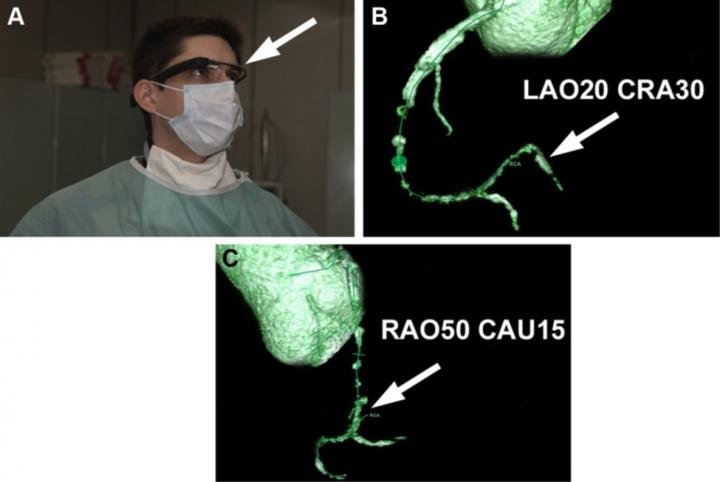Virtual Reality Device Helps Treat Blocked Arteries
By MedImaging International staff writers
Posted on 29 Nov 2015
A wearable virtual reality (VR) device based on Google Glass can be used to guide revascularization of chronically blocked coronary arteries.Posted on 29 Nov 2015
Developed by researchers at the Institute of Cardiology (Warsaw, Poland), the optical VR device projects three-dimensional (3D) coronary computed tomography angiography (CTA) reconstructions to a wearable head-mounted display that is worn by interventional cardiologists in the catheterization laboratory. The projection of the 3D CTA reconstructions onto the screen of virtual reality glass allows the operator to clearly visualize the distal right coronary vessel and verify the direction of the guide wire advancement, relative to the course of the occluded vessel segment.

Image: CTA images displayed in Google Glass (Photo courtesy of the Canadian Journal of Cardiology).
The wearable computer, which is also equipped with a hands-free voice recognition system and a zoom function, was developed specifically by a team of physicists at the Interdisciplinary Centre for Mathematical and Computational Modelling of the University of Warsaw (Poland) to improve procedure efficiency in interventional cardiology by enabling physician-operators to clearly visualize coronary vessels. The study describing the development and first -in-human use of the VR device was published on November 19, 2015, in the Canadian Journal of Cardiology.
“Mobile technology is easily accessible and offers an incremental opportunity to expand the existing open platform for mobile applications, which might in turn overcome the economic and capacity limitations of advanced angiography systems with dedicated monitors for projection of CTA data sets,” said lead author Maksymilian Opolski, MD. “Wearable devices might be potentially equipped with filter lenses that provide protection against X-radiation. We believe wearable computers have a great potential to optimize percutaneous revascularization, and thus favorably affect interventional cardiologists in their daily clinical activities.”
Chronic total occlusion, a complete blockage of the coronary artery, represents a major challenge for catheter-based percutaneous coronary intervention (PCI) due to unpredictable procedural success rates that are related to incomplete visualization of the occluded coronary arteries by conventional coronary angiography radiology methods. As a result, coronary CTA is being increasingly used to provide physicians with guidance when performing PCI in this subset of lesions.
Related Links:
Institute of Cardiology
University of Warsaw














